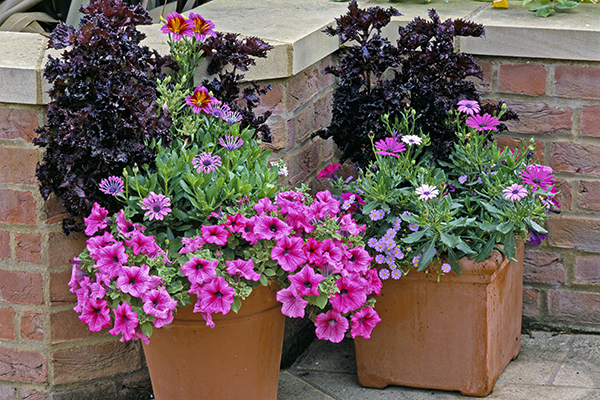By Rita Bricker

Do you yearn to dig in the dirt and grow your own vegetables or flowers, but fear that the gardening gene has skipped a generation in your family?
There is a way for you to accomplish your gardening dreams, and it is simple : Container gardening. Virtually anything can be grown in pots or other containers both conventional and non-conventional in form. In these days of smaller and smaller residential yards, container gardening may make even more sense for you.
The key ingredients for any successful gardening effort are good soil, proper watering, adequate nutrients and suitable light. With container gardening, you can control all of these.
SOIL
Our alkaline southwest soil need not be a concern when you grow your plants in containers. Just fill those containers with the appropriate potting mixture that can be purchased from your nearby garden center. There are specialty potting blends available for cactus and succulents, palm trees, roses and citrus, as well as general purpose soil for flowers and vegetables.
Our alkaline southwest soil need not be a concern when you grow your plants in containers. Just fill those containers with the appropriate potting mixture that can be purchased from your nearby garden center. There are specialty potting blends available for cactus and succulents, palm trees, roses and citrus, as well as general purpose soil for flowers and vegetables.
Many of these potting mixtures contain moisture-retaining components like perlite or vermiculite. Even so, it is common for containerized plants to require more frequent watering than comparable plants in the ground, as the soil in pots tends to dry out quicker.
WATER
A moisture meter will tell you when your container plants need watering. Mulch on the surface of the soil will conserve moisture. Deep, slow watering is preferred, but correct watering requires good drainage so roots do not rot from excess moisture. Be sure pots or other containers have at least one good drainage hole in the bottom.[quote_box_right]Gardening Tips
With temperatures climbing near the century mark, it is time to adjust your watering schedule. Keep the watering interval the same, but extend the duration of each watering application.[/quote_box_right]NUTRIENTS
In addition to more frequent watering, containerized plants will likely require more frequent feeding as well. Why? Because nutrients present in the soil are leached out with watering. As with potting soils, there are fertilizers blended specially for different types of plants, as well as good all-purpose fertilizers available to you. Just be sure to follow package directions for feeding plants in containers; they generally require less food per application to offset more frequent feeding.
A moisture meter will tell you when your container plants need watering. Mulch on the surface of the soil will conserve moisture. Deep, slow watering is preferred, but correct watering requires good drainage so roots do not rot from excess moisture. Be sure pots or other containers have at least one good drainage hole in the bottom.[quote_box_right]Gardening Tips
With temperatures climbing near the century mark, it is time to adjust your watering schedule. Keep the watering interval the same, but extend the duration of each watering application.[/quote_box_right]NUTRIENTS
In addition to more frequent watering, containerized plants will likely require more frequent feeding as well. Why? Because nutrients present in the soil are leached out with watering. As with potting soils, there are fertilizers blended specially for different types of plants, as well as good all-purpose fertilizers available to you. Just be sure to follow package directions for feeding plants in containers; they generally require less food per application to offset more frequent feeding.
LIGHT
The final consideration for container gardening is sunlight and weather. With the portability of containers, plants can be moved into or out of the sun as needed and can be more easily protected from harsh winds. For large containers, a “pot trolley” on wheels makes container mobility very easy. And the ability to thwart some of the worst effects of climate with portable plants may allow you to grow something more challenging than you might have thought possible.
The final consideration for container gardening is sunlight and weather. With the portability of containers, plants can be moved into or out of the sun as needed and can be more easily protected from harsh winds. For large containers, a “pot trolley” on wheels makes container mobility very easy. And the ability to thwart some of the worst effects of climate with portable plants may allow you to grow something more challenging than you might have thought possible.
Rita Bricker is co-coordinator of the Master Gardeners in Maricopa. She supervises the staff and activities of the Pinal County Master Gardener diagnostic office in the Maricopa Agricultural Center.
This column appears in the May issue of InMaricopa.

















![Shred-A-Thon to take place tomorrow An image of shredded paper. [Pixabay]](https://www.inmaricopa.com/wp-content/uploads/2024/03/shredded-paper-168650_1280-100x70.jpg)
